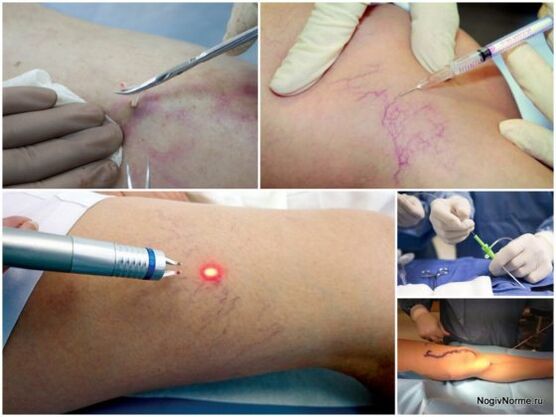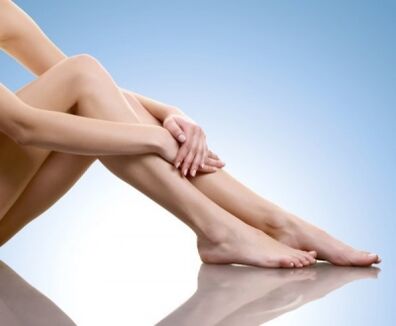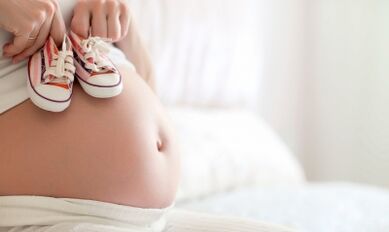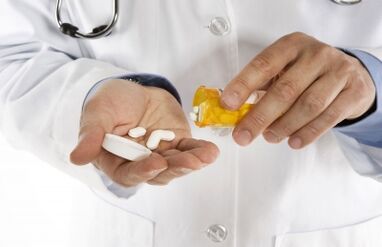According to statistics, up to 20% of the population suffers from varicose veins of the veins of the lower limbs, while in women the disease occurs 2 times more often.Women have been shown to have further predisposing factors that contribute to a decrease in vascular tone (pregnancy, intake of estrogen-glitched contraceptive drugs, an imbalance of sex hormones).The types of treatment of the veins of the legs in men and women do not differ, however the frequency of postoperative recurrence in women is higher due to the additional influence of hormones (estrogen influence and progesterone).
Venous legs of the legs must be treated by a phlebologist who is engaged in this pathology.Various methods for the treatment of varicose veins are not radical, since they do not aim to eliminate the main pathogenetic cause - the failure of the vein valve system.Surgical and conservative treatment delays the progression of the disease on long lines.The percentage of recurrence is high and reaches 10-50% after 5 years after surgery.
The treatment of varicose veins should be complex.There are three groups of methods to eliminate varicose veins:
- Flebosklering,
- surgical,
- Conservative.
Each type of treatment has its advantages and disadvantages, a certain frequency of recurrence.The choice of the method is conditional, since a phlebologist to achieve the most favorable result must often combine all three methods.
General events, characteristics of men and women
The symptoms of varicose veins begin with the appearance of these functional disorders such as a feeling of gravity in the legs, swelling of the ankle joints by the end of the working day.On the skin of the legs, the vascular stars are formed first.
Vascular stars are one of the first symptoms of the development of varicose veins.
The main signs of the disease - the unification of varicose veins appear a few years after from the beginning of the disease.
In the absence of treatment at this stage, there are symptoms like cramps in the calf muscles, the itching of the skin on the legs.
Signs of trophic disorders: skin pigmentation in the lower third of the lower part of the leg, cyanosis, sclerotic changes in the subcutaneous tissue, eczema, against which an ultimate trophic is formed.
Characteristic symptoms of varicose veins in women
- The painful symptoms appear cyclically, improved before menstruation, which is associated with a change in the level of sex hormones;
- During pregnancy, the signs of the varicose veins after childbirth can disappear;
- In the second half of the menstrual cycle due to the action of progesterone, the diameter of varicose veins increases, therefore the symptoms of swelling and gravity in the legs are more expressed;
- The signs of varicose veins are aggravated during hormonal therapy.
Now let's talk about therapy methods.

Methods for treatment of phlebosclerosis
Radiff ablation and endenosis laser coagulation
ABLATION AT RADIOFROQUENCY OF THE VEND
The method is based on the introduction of a special disposable catheter throws under the ultrasound in the light of an expanded vein.
The catheter is equipped with a special electrode, whose part of work is heated to 120 degrees under the influence of radio frequency radiation.The promotion of the catheter throughout the vein leads to glue or "produce" the vascular wall.The oblique veins are deactivated by the circulatory system of the legs.
Endoxic laser coagulation
The operation of the operation consists of a drilling of the vein concerned and the introduction in its light under the ultrasound control of laser light.Under the influence of laser radiation, the coagulation of the proteins of the vascular wall occurs, due to which the vein falls and after a while it is covered with connective tissue.
Radio -frequency ablation (RFA) and the laser prison of Endhenosis (Evlo) are relatively new methods for the treatment of varicose veins on the legs.Despite the differences in the implementation technique, they have general characteristics.
Advantages and disadvantages of Rh and Eullo
| Do not request hospitalization | High price |
| Execution speed (from 30 minutes to 1 hour) | Release frequency up to 10% |
| Painless | The impossibility of performing the procedure in some anatomical characteristics of the veins (strong winding of ships) |
| Brushed | |
| Performed under local anesthesia | |
| Lack of postoperative scar (the desired effect for women) | |
| Short rehabilitation conditions |
RFA or Evlo is chosen by women who want to treat varicose veins in an outpatient way with a minimum limitation of physical activity in the postoperative period and while maintaining the aesthetic type of leg.
Flebosclerotherapy

A special drug is introduced in the light of the segment of affected veins, which has a sclerosing effect ("gluing") on the vascular wall.A sclerosing agent can be used in liquid form or in the form of foam.Preference should be given to sclerotherapy in foam due to the largest contact area of a substance with a vein wall.
Advantages and disadvantages of phlebosclerotherapy:
| The absence of a postoperative scar | The pigmentation of prolonged skin on the drilling site (up to 2 years) is possible |
| Carried out on an outpatient basis | In rare cases, postoperative inflammation of the vein (Flebitite) |
| The operation is performed without anesthesia | Swelling and redness of the fabrics within 2 days of the procedure |
| The manipulation is almost painless (light burning on the puncture site) | Allergic reaction with individual drug intolerance |
| In 20% of cases, vascular stars appear on the legs.Release frequency of up to 50% |
The relapse of the varicose veins after sclerotherapy depends on the lumen of the interested vase: the greater the clearance, the greater the risk of recanalization in it.Sclero therapy is chosen in the treatment of the relapse of varicose veins after surgical phlebectomy.
Surgical phlebectomy
Surgical surgery is a more radical way to eliminate varicose veins.The principles of surgical treatment are the elimination of the pathological discharge of the blood from the deep in the superficial veins of the legs and the removal of the expanded vessels themselves.Combined phlebectomy phase:
- Intersection and dressing of the mouth of a large subcutaneous vein (groin section) or a small subcutaneous vein (engraving in a popliteal pit);
- Removal of the barrels of varicose veins.It is performed using a special metal probe, which extends a vein into a skin incision.
Advantages and disadvantages
| Radicality | Hospitalization from 5 to 7 days |
| The ability to perform surgery at any phase of the disease | A scar on the legs |
| Anesthesia of the cerebrospinal liquid or general grass of the surrounding tissues when stretching is complications of the Vetly: bleeding, relapse wound infection up to 20% |
It is preferable to treat with the operational way with a type of damage to the stem, when a varicose deformation of large or small subcutaneous veins occurs for a significant length.And even when there are signs of trophic disorders of soft tissues and symptoms of decompense of venous insufficiency.
Miniflectomy
MINIFLEBECCTOMY is a separate version of surgery where it is possible to treat varicose veins in the initial stages.It is more often used in the presence of individual varicose veins on the legs.A drilling of the skin is performed on pathological formation and with the help of the hook, the vein is stretched and intersects.The operation does not require general anesthesia and the overlap of skin seams.
It is necessary to start treating varicose veins on the legs using drug and compression therapy.The appointment of drugs that improve blood circulation and wear medical compression knitwear are the main conditions that determine the result of any surgery on the legs of the legs.
For a long time it is necessary to treat phlegonic and anti -aggregate drugs on the legs in continuous mode or in the form of repeated courses.
Drug therapy
Medicines stop the symptoms of venous insufficiency, they are used as a preoperative preparation and postoperative rehabilitation.
Compression therapy
Elastic compression of the legs is the main method of treatment in cases where surgery is contraindicated.As compression products, you can use elastic bandages and special medical knitwear: socks, golf, tights.Medical products are highly durable, they maintain the initial compression level for a long time, convenient when wearing, which is important for women.
There are 4 classes of elastic knitwear depending on the degree of compression.It is recommended to treat varicose veins using grade 2 products in the absence of a progression of the disease up to 6 months and with further use for physical activity or with prolonged living room on the legs.If there are signs of deep vein valves or pronounced symptoms of altered lymphatic flow, the third -class jersey products are prescribed before stopping the progression of varicose veins.
The therapeutic effect of the compression knitting is due to:
- a decrease in the volume of the vein, which leads to a smaller download of blood in varicose vessels;
- An increase in the absorption of the tissue fluid in the bloodstream, due to which signs of swelling and symptoms of severity disappear in the legs;
- Improve the fluidity of the blood, which prevents blood clots.
How to treat varicose veins on women in women
The correct answer to the question about how to treat varicose veins on women in women is the possibility of a high quality and full life.It is not a secret for anyone who ignores measures and therapeutic consultations by a doctor leads to deplorable consequences: disability, emergence of trophic, thrombosis ulcers and the worst option is a fatal result.
Clinical image of varicose veins
As medical statistics show, the cause of varicose veins is a hereditary factor, therefore, knowing the problem of your relatives, it is necessary to engage in the prevention of the disease from a young age.
In addition, doctors distinguish the causes of varicose veins in women:
- hormonal violations;
- unhealthy nutrition, excessive use of fat;
- high cholesterol;
- renovate the body with menopause;
- long stay in a position at work or home;
- strong physical activity;
- Passive lifestyle, minimum motor activity.
Each of these factors influences the normal functioning of the blood in the lower ends, which causes the development of the disease.
It is important to remember that the causes of varicose veins in women are often compressive clothes, high heels and nearby linen.
Unfortunately, not all women give due importance to the symptoms in the initial phase of the development of the disease.The symptoms of the varicose veins are deleted for legs of the legs, heat, uncomfortable shoes, waste pants.It is an early diagnosis that allows you to choose effective treatment and quickly save a woman from the problem.
A woman can feel such signs of varicose veins:
- The feet, the lower parts of the legs begin to swell in the evening, while the swelling may appear on both two legs and on one;
- A feeling of incredible burning in the part of the leg calf;
- A small shirt of blood vessels can form on the skin;
- The pigmentation of the skin occurs, the vascular stars appear in the lower part of the leg;
- Convulsions may appear at night;
- Vienna rises on the surface of the muscles, while any touch to them causes pain.
The appearance of this disease can be accompanied by a change in the structure of the skin, it will be more dense, abrasions and conversing are manifested more often on it even from a slight blow.
A woman can diagnose varicose veins on the legs in an initial phase, it is her attention to her body that will allow treatment and avoid serious complications over time.
Modern treatment methods
When choosing a method of treatment, the doctor will focus first on the reason that caused varicose veins.It is the elimination of pathological changes that will take care of the disease.
Varicose veins on women can be treated in different ways:
- Surgery.
- Drug therapy.
Drug therapy includes a wide range of drugs that help to cope with the disease in the various stages of its course.The easiest and most effective way will be to use ointments.Many of the ointments owned allow to eliminate different symptoms simultaneously, including pain.
Medicines are selected individually only by the attending physician, but are necessarily included in these groups:
- Flebotonic.The drugs perfectly face the edema and prevent the appearance of convulsions at night.
- Analgesics.Used in the case of severe pain.
- Drugs based on aspirin.They help to dilute blood, preventing the new aspect of blood clots.
- Vitamin complexes containing vitamin E.
If the surgical method should be used in the treatment of varicose veins, the doctor can offer different options for surgery:
- Flobectomy.The operation is performed on a painful limb and a vein deformed by varicose veins is surgically extracted.
- Endaxic coagulation with a laser.This is an innovative method, which allows you to perform prison of varicose veins.Laser treatment is gaining more and more popularity, as it is less traumatic.
- Use of radio frequencies for coagulation.This operation is performed in the outpatient treatment, the patient does not even need hospitalization.
- Sclerotherapy.This method allows you to glue damaged veins using special substances that are inserted inside.
Even in the treatment they are important in the treatment.It is used as an auxiliary tool as prevention.Wearing compression linen offers many advantages and the treatment is faster.
Among the main advantages of these underwear, doctors call the following:
- reduction of loads on inflamed vessels;
- normalization of blood circulation in the limb;
- minimization of the risk of blood clots;
- Complete safety and lack of side effects.
Wearing compression linen and elastic bandage is allowed only during the day, at night the legs should rest.
What does traditional medicine offer?
Traditional medicine has many prescriptions that help to cope with the disease.But it is worth remembering that any of the recipes should be used in complex therapy and only after consulting the attending physician.The car -mediation can end and bring more serious complications.
There are such popular recipes for the treatment of varicose veins:
- As a compress to relieve swelling and pain, you can use an ointment made of butter and garlic.The ground garlic is mixed with butter and applied to the leg, left all night.
- To relieve inflammation from the inside, it is possible to use nettle tincture.2 tablespoons of chopped nettle are poured with a glass of boiling water and insisted.Drink the resulting product 50 ml for 2 weeks.
- The nutmeg on the ground is poured with a glass of boiling water and a spoonful of honey is added.All this must be drunk before meals in an hour.
- It is good to use chestnut tincture for horses like rubber.To prepare it, you will need 50 grams of crushed chestnuts and 250 ml of vodka.You have to insist on the product within 14 days, stirring constantly.
It is important to remember that the car -mediation or the use of only popular recipes can end up fatally or bring more serious complications.
Complications that could be in the absence of treatment
What is the danger of varicose veins on women's feet?What are the consequences with improper treatment?
This disease is not a cosmetic problem, therefore it requires immediate and professional treatment.
Experts highlight these possible complications and consequences:
- Any delay in treatment can cause bleeding, thrombosis or overlap of partial veins.
- Ignoring medical assistance can cause the development of an ulcer trophic, thrombophlebitis.
- If the blood systematically circulates through Vienna, a venous deficiency can develop.
- About 1% of all patients receive disability or death.
With the varicose veins of the lower ends, the treatment should be complex, regular and professional.It is worth remembering that life and health always depend on the patient himself.
Do you know everything about how to correctly treat varicose veins on women in women?

Varicosis is a disease of the veins of the lower ends, in which the expansion of subcutaneous veins develops in people who have not previously painted thrombosis.
Even with the help of radical surgical operations, it is not always possible to obtain a complete recovery.
However, varicose veins are required, since it tends to progress and develop furtherComplications: thrombophlebitis, trophic ulcers, bleeding.
Causes and symptoms
According to statistics varicose diseasesIn women, it is diagnosed 4 times more oftenof men.Since pregnancy is a traditional risk factor for the development of varicose veins.The expansion of varicose veins during pregnancy is due to the influence of a series of factors on the body of a woman:
- an increase in the volume of circulating blood;
- A change in the hormonal background, i.e. an increase in the level of progesterone;
- an increase in the volume of the uterus, which tightens the retroperitoneal veins;
- Increase the intra -abdominal pressure during childbirth.
Varicose veins during pregnancy develop already in the first months, manifested by the clinical symptoms in the middle of the second and the beginning of the third quarter.
The second unfavorable factor that causes the disease is the increase in body body in women during menopause, which is also due to the influence of hormones.Female hormones are estrogen, progesterone reduces the tone of the veins.
The third cause of varicose veins in women.Of little importance in the occurrence and development of the disease isLife.According to statistics, the frequency of varicose veins in women with sedentary work is observed in 37%.People forced to be in a vertical position for a long time (teachers, cooks, hairdressers, sellers) - in 63%.For comparison, in men, these data are three times lower.
The effect of the inheritance on the development of the disease has not been completely studied, however, 25% of patients detected relatives suffering from this disorder.
Signs of varicose veins in women
The beginning of the varicose veins can occur in different ways:
- The appearance of subcutaneous varicose veins.
- Varixes' appearance - venous knots that shine through the surface of the skin, which appears in the form of snakes.
Furthermore, the first signs of the varicose veins are not accompanied by other symptoms,The serious manifestations of the disease develop after a few years.
Symptoms of varicose veins in women:

- After 3-5 years- "tired legs" syndrome: a feeling of heaviness, hum, explode in the legs, especially in the evening after a working day.After relaxing in a vertical position with the feet raised, the symptoms of the disease are agitated with themselves.
- After 5 - 10 years- Trophical disorders: darkening, thinning of the skin, ulceration.
- After 10-15 years- The impenetrable edema, located more often in the area of the lower part of the leg, does not rise above the knee.The diffusion of the edema in the thigh indicates the presence of thrombosis.
During pregnancy, the symptoms of varicose veins develop much faster.As the gestational age increases and the growing uterus, there is a feeling of pain and severity in the legs, transforming itself into a edema of the lower part of the leg.
How to treat varicose veins on women in women?
Successful treatment of varicose veins should solve the following problems:
- elimination of varicose veins;
- elimination of the symptoms of the disease;
- Registration prevention.
The first problem is solved by phlebosclerosal therapy or surgery.
Conservative therapy aims to eliminate the symptoms of varicose veins (pharmacological treatment + compression) and prevention (physiotherapy exercises. Elastic compression).
In the early stages of the disease, the treatment is only conservative:
- Drug therapy in the tablets - phlegm and anticoagulants (as prescribed by a doctor).
- Local use of Venotonizing Ointments and Gel.
- Elastic compression.
- Physical medical and gymnastics education.
- A healthy lifestyle and proper nutrition.
CompressionConservative therapy is mandatoryIn all phases of varicose veins, it is possible to eliminate the stagnation of the blood and recreate favorable conditions for the microcirculation of the blood vessels.Depending on the degree of varicose disease, knitwear withoptimal pressure.In the initial stages of the disease, compression of the first class is used, for varicose veins with the "tired legs" syndrome - 2 class, with a complicated course of 3 classes.
Pharmacological treatment

The treatment of varicose veins on the legs in women is performedCourses from 2 to 3 months twice a year.When varicose veins, phleboprotectors use drugs that eliminate the manifestations of the disease, increase the tone of the veins, improve the microcirculation of the blood vessels and prevent the formation of the inflammatory process in the vascular wall.
Flavonoid -based medicines are successful in phlebological practice(The substances contained in plant organisms) are derivatives of rutin and diosmina and gest.
To quickly relieve symptoms, ointments and gels are used for local use.
Pharmacological treatment does not take care of patients, but slows down the progression of the disease.
Domestic treatment
Are many women interested in how to treat varicose veins on women's feet at home?Therapeutic gymnastics, phytotherapy and some recommendations on a healthy lifestyle for patients with varicose veins will help alleviate the symptoms of the disease and prevent further development.
Therapeutic exercises
Every day in the morning and in the evening, you have to perform simple exercises for varicose veins:
- Lie on the back, raise your legs vertically, placing them against the wall with a 90 ° angle.Keep them in this position for 3 minutes, slowly breathing with the chest, not a stomach.
- In the position of lying on the back, make a bicycle, 3-5 minutes.
- Standing, climbing with two legs on socks 1 cm from the floor and descending.Perform 30 times in two approaches.
- Standing, alternatively lift one heel from the floor, then another, with a corner not exceeding 45 about 45.It starts from 15 minutes a day, extending to 30 minutes.
The day should be given time to walk, at least 30 minutes.It is useful to go to the pool once a week.




















